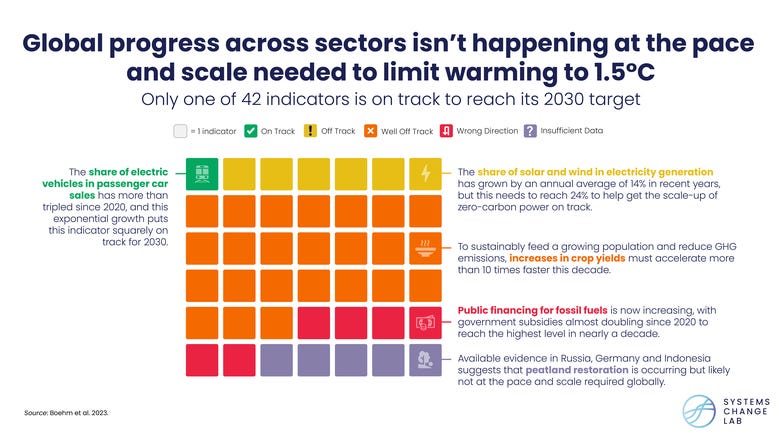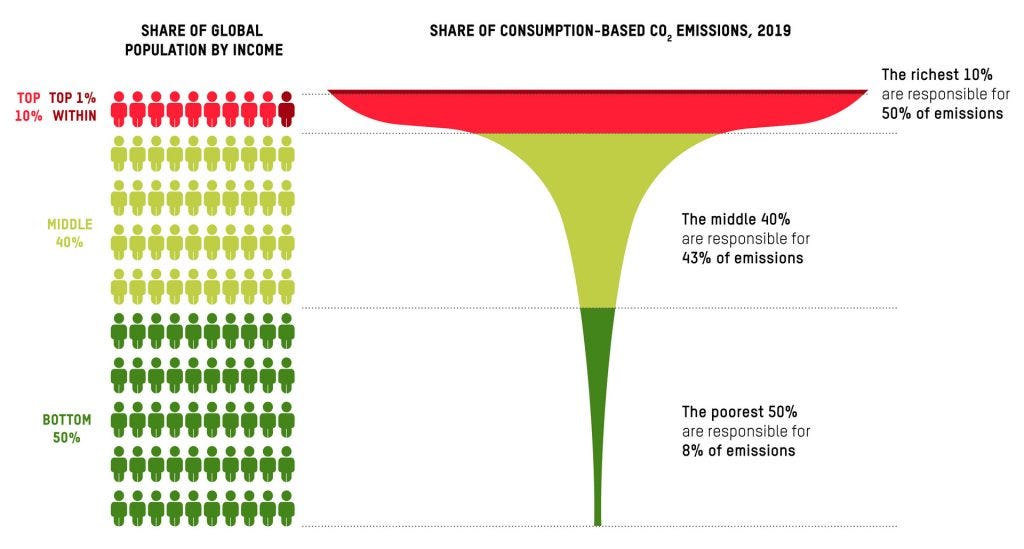Photo by Lux Charters on Unsplash
In the last few weeks, I came across two charts that sum up the predicament of climate change pretty well and illuminate the trap we have set for ourselves. The first is from The World Resource Institute’s Climate Change Lab report, The State of Climate Action 2023. The below chart summarizes the findings of the report. Only one of the 42 indicators they follow is on track to reach 2030 targets to keep global warming to 1.5C above pre-industrial levels.
The only target on track is the rate of electric vehicle adoption. While that is encouraging, hitting EV targets alone isn’t going to change much. The six metrics headed in the wrong direction entirely (the ones in red) include:
- Industry – The carbon intensity of industry (steel, cement, etc.) is still increasing
- Transport – There has been an increase in the percentage of trips in cars needed
- Transport – Reduction in the share of Battery and Fuel Cell electric bus sales
- Forest and Land – Mangrove loss is accelerating
- Food and Agriculture – The share of food production lost is increasing
- Finance – Public financing of fossil fuels is increasing.
According to the report, some of the ways we can reach these global goals are:
Increase growth in solar and wind power. The share of these two technologies in electricity generation has grown by an annual average of 14 percent in recent years, but this needs to reach 24 percent to get on track for 2030.
Phase out coal in electricity generation seven times faster than current rates. This is equivalent to retiring roughly 240 average-sized coal-fired power plants each year through 2030.
Expand the coverage of rapid transit infrastructure six times faster. This is equivalent to constructing public transit systems roughly three times the size of New York City’s network of subway rails, bus lanes and light-rail tracks each year throughout this decade.
The annual rate of deforestation — equivalent to deforesting 15 football (soccer) fields per minute in 2022 — needs to be reduced four times faster over this decade.
Shift to healthier, more sustainable diets eight times faster. This involves lowering per capita consumption of meat from cows, goats and sheep to approximately two servings per week or less across high-consuming regions (the Americas, Europe and Oceania) by 2030.
Now hold those facts in your head and take a look at this next chart from the recent Oxfam report, A Planet for the 99%.
Source: Oxfam/SEI: A Planet for the 99% (2023)
This chart shows global income groups and associated consumption emission in 2019. Rest assured the emissions data from 2019 is going to mirror today’s data. What this shows is that the richest 10% on earth are responsible for half the emissions, while the poorest 50% are responsible for only 8% of emissions.
What does this mean?
Consider that with very few exceptions, the richest 10% are the ones holding the levers of power in the world. Whether it be through government, companies, or investments, the richest 10% hold the power to change, or not change the status quo. We see from the two charts above that the 10% are the ones behind the CO2 problem and the ones doing very little about it.
It is this 10% that has the power to change things. And they are choosing, either actively or passively to do very little. I won’t say “nothing”, because 1 out of 42 metrics are going in the right direction, but 1 out of 42 is a dismal batting average (.024 if you are wondering). We need much better. But we aren’t getting it.
I’m not whining about the current system and saying that it’s unfair. I’m saying it is a stupid way to run a planet. The business of apocalypse bunkers is booming, while we do very little to stop climate change.
I’m not talking about starting class warfare – that’s already happening.
Class warfare is already here. The concentration of wealth around the world isn’t an accident. There is no great cabal at work. In the words of the late, great comedian Geroge Carlin, “You don’t need a formal conspiracy when interests converge.” People do what they are incentivized to do. If the 10% or the 1% can capture the system and make it work for their interests over those of most of society, they will do so. In many places in the developed world, they have done so quite effectively.
The below chart from the visual capitalist (really recommend them) sums up the current state of global wealth.
Source: The Visual Capitalist
When 1.1% of the world’s population holds half of the worlds wealth and therefore the world’s power, while 80% of people on Earth say they are willing to make changes in how they live to combat climate change, and they see relatively nothing being done, well I don’t see how that leads to social cohesion. That leads to things like the French Revolution. That leads to an increase in populism around the world. It doesn’t lead to an answer to our climate change problem.
What is the answer?
The answer is simple. But it is in short supply.
The reason this system is sleepwalking to the apocalypse is the most powerful force in the universe: inertia.
Cultures usually don’t change because people see a problem coming and they fix it. Cultures usually change after something breaks and they start over. That is a very expensive and dumb choice, but it is the one we are collectively making because so many people have an interest in the status quo.
Even those in that bottom 50% don’t want their lives upended. They don’t want their routines changed. An issue like climate change is something they’ve heard about, but it isn’t in their home every day. The things that are in their homes every day are their kid's education, the health of their family, and trying to pay the bills. Big broad issues like war, the global economy, and climate change are always going to take a back seat to what is happening at home. Once those issues reach someone’s front door it is too late.
That is what leadership is for.
It is what we are lacking.
Leaders are supposed to tackle those big issues and talk with their constituents about what is going on, why it is happening, and what is being done about it.
Climate change can be solved with leadership. Someone, or better yet someones standing up and saying – often and repeatedly. I’m sorry, but we can’t live this way anymore. We must commit to changing how we live and here is how. Eighty percent of people in the world are ready to hear that message and are willing to act on that message, and yet we rarely hear it.
We hear plenty about green technologies and green growth, but that is focused on keeping the status quo and not upsetting the status quo. That alone won’t get things done. Talk about green growth and net zero targets have done little. The Economist ran an article this past week where they assigned letter grades to the world’s efforts to tackle climate change. The only satisfactory grade was “making commitments” (so talking). The action grades of “keeping to commitments), “investment” and “adaptation” were all Ds. We are failing at action.
Don’t worry, money can solve this too.
I saw a great headline recently: “It is now cheaper to save the world than to destroy it.” The article itself is about how Kazakhstan is struggling through the energy transition, but it was the headline that stayed with me.
It was both inspiring and maddening. Inspiring because it signals hope that we have turned a corner now that the world of finance and investors can see the promise and profit in saving the world. It was maddening to understand that we would not save ourselves until we saw that we could profit from it.
Now that we are realizing that we can use our money to save ourselves, will we do it? Doing so will require us to make hard choices. These choices include winding down industries that are destroying us even if that hurts some investors and certain parts of the economy. It means moving away from the status quo towards an economy where well-being takes precedence over growth. It means leveling with people about what is coming, telling them how they can help get us where we need to be, and showing them how that is done through leadership.
And it likely means that those of us in the 10% have to take the responsibility to lead in solving this problem. That will take lots of money. Ask the billionaires in your life if they would rather have $500 million on a planet that is thriving, or $1 billion in their bunker, with no staff to serve them and food and water hard to come by. They may retort that they don’t believe that will happen.
That’s when you ask them, “Then why do you need the bunker?”





